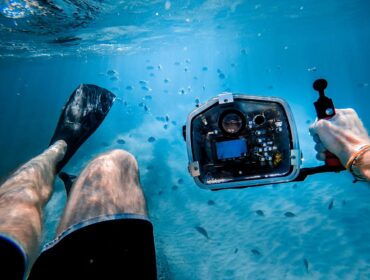Underwater photography is one of the many ways you can enjoy your scuba experience. With so much life under the surface that is in constant flux, there are infinite possibilities for subject matter and composition.
However, there is a bit more involved than just pointing and shooting. The very nature of the water creates unique obstacles that don’t occur on land, but rest assured you can overcome them by learning about these issues and practicing your technique.
One of the most common challenges underwater photographers face is color saturation. Because the longer wavelengths of sunlight that we perceive as orange, yellow and red are more quickly absorbed by the water than shorter wavelengths like blue and green, the result of photographs taken underwater can be devoid of any colors but blue and green.
The further from your subject you are, the more likely it is that your photos will be hues of one color, rather than true to the actual scene. This can be very frustrating if you invested a lot of time and interest in capturing these photos.
There are several practical solutions to this problem. One very simple solution is to use a red filter on your lens, which will help balance out the blues and greens. Another is to use either a wide angle lens, or a macro lens.
A wide angle lens allows for much closer focusing than a traditional lens, because the focal point of the lens in within a shorter distance and has a wider frame of vision. The macro lens is designed to get up close and personal with your subject with a high level of definition. Remember, the further you are from your subject, the less distinction will be visible in your photos.
Yet another way to maximize the detail of your subject is to use a flash unit, even if it is daylight and the world around you seems bright. What the flash does is bathe your subject in full spectrum light, making the true colors visible while retaining the lovely blues and greens of the ocean.
A strobe flash is highly recommended over your camera’s internal flash, as it is possible for your camera housing to diffuse or block the light. While it may take some practice to get the density correct, you will know the time was well spent when reviewing the beautiful photos you’ve taken.
With the advent of digital cameras, there are now technical options such as white balance controls. The fluorescent setting closely mimics underwater lighting, so try this setting to achieve clearer results. One of the best aspects of digital photography is that you can review your work as it is in progress, simply deleting the photo instantly if it doesn’t come out right. There is also a wide array of photo editing software that can salvage pictures that may otherwise be lackluster due to color absorption.





